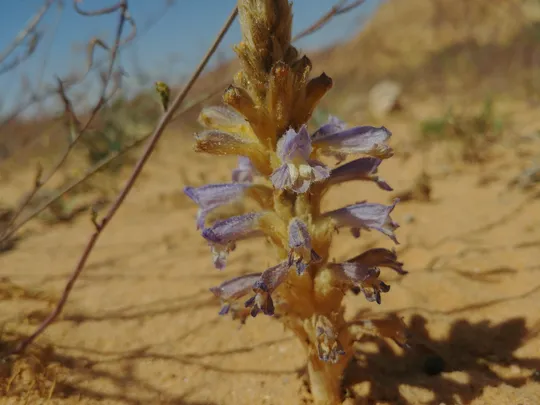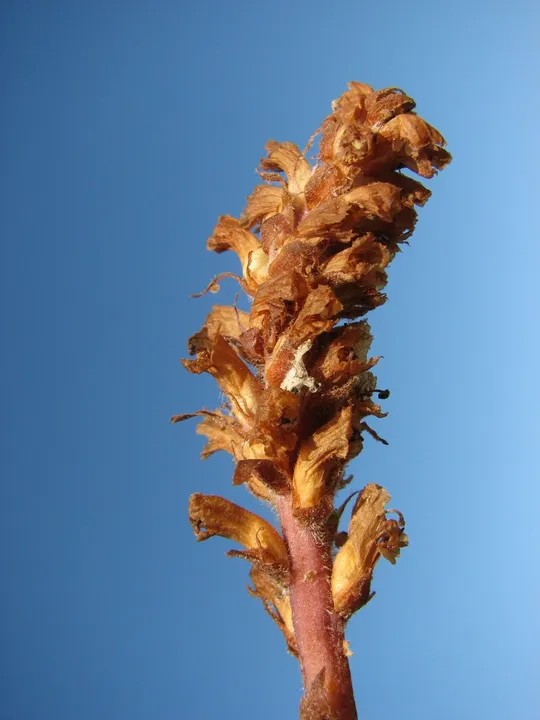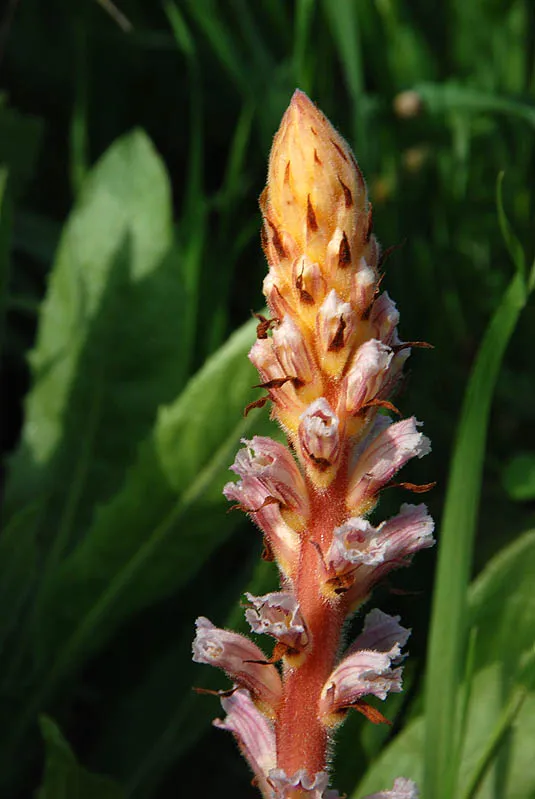Schltz' Broomrape
Orobanche schultzii

Orobanche schultzii is currently found with certainty only at one site in
the Samarian Mountains – in Amona, east of Ofra at an altitude 830 meters, where
it was found in 2009. According to the Flora Palaestina and to Danin (2004),
the species is found in the Judean Mountains, Samarian Desert, Moab and Gilead,
but there is no evidence of this in the Herbarium. It also grows on the Hermon,
but it is unclear whether it grows in the Edom Mountains.
Montane valleys and rocky slopes on
calcareous substrates at altitudes of 700-900 meters. Outside of Israel Orobanche
schultzii grows in diverse habitats, not necessarily in
agricultural fields, from sea level up to an altitude of 2,560 meters.
Orobanche schultzii
belongs to the Trionechon section in the genus Orobanche, which is characterized by a campanulate calyx,
undivided into lobes, with two lateral bracteoles to the side of the bract.
This group includes the rare O. lavandulacea and the most common Orobanche
species in Israel – O. muteli (= O. aegyptiaca). Unlike O. muteli that has a branching stem,
O. schultzii has a short unbranched erect stem. The lobes of the
lower corolla lips in O. schultzii are pointed and not rounded
as in O.
muteli. Another important sign is the location of the "constriction
in the corolla tube": While in O.
muteli, the narrow part of the corolla tube is half the
length of the tube, in O. schultzii the corolla tube is
constricted far below the middle. The lower labium of the corolla lacks two
white protuberances, which are characteristic of O.
muteli.
The distribution of the Trionechon section species
is mainly Mediterranean. Most of the species grow in natural habitats together
with local plant associations and only one of them has become an agricultural
pest.
·
Orobanche schultzii grows with certainty at only one site in Samaria, and
because of difficulties in identification it is doubtful if it ever grew in other
regions. It is therefore difficult to conclude if there is a trend of change in
the number of regions and sites.
·
There is no information available on the global threat state
of O. schultzii, but given its relatively broad geographic
distribution, we can assume that it is not globally endangered.
It is very important to conduct a field
survey to locate Orobanche schultzii populations and sites. This should be
followed by research to diagnose and verify the systematic and genetic
characteristics of the species in Israel. A site for preserving the species
should be set aside in the Jerusalem Hills or Samaria and O.
schultzii populations should be monitored there.
Orobanche schultzii
is a Mediterranean species that on one hand grows in
Mediterranean North Africa (it was first described from Algeria) and on the
other hand grows in most countries of Southern Europe, Turkey, Lebanon, Cyprus
(?) and continues eastward through northern Iran to Afghanistan. In Egypt's new
Flora, the species is noted from Alexandria.
Orobanche schultzii is a very rare
plant in Israel that over the past ten years has been found only at a single
site in Samaria. Due to its rarity, its current distribution is not clear, nor
is it clear whether additional sites from where it was previously noted are mistaken
identifications or evidence of extinction; a thorough field survey should be
conducted to locate populations.
Current Occupancy Map
| 1000 squre meter pixel | 5000 squre meter pixel | 10000 squre meter pixel | |
|---|---|---|---|
| number of observations | 0 | 0 | 0 |
| in total pixels | 0 | 0 | 0 |
| Family | Orobanchaceae |
| Classification | On the endangered species list |
| Ecosystem | Mediterranean |
| Chorotype | Mediterranean |
| Conservation Site | HaTsninim Valley between Amona and Ofra in Samaria |
| Rarity |
1
6
6
|
|---|---|
| Vulnerability |
0
0
4
|
| Attractiveness |
0
0
4
|
| Endemism |
0
0
4
|
| Red number |
1
3.7
10
|
| Peripherality | N |
| IUCN category | DD EW EX LC CR EN VU NT |
| Threat Definition according to the red book | Vulnerable |
 Based on:
Based on:






